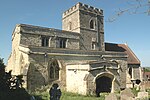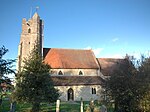Beckley Park

Beckley Park is an English country house located near the village of Beckley, in Oxfordshire, England. It was built in 1540 by Lord Williams of Thame, who also built a great house at Rycote, a few miles away. It was originally built as a lodge for use when the lord and a party hunted the great park. Today it is the home of Amanda Feilding and the main headquarters of her Beckley Foundation which is doing research on the benefits of certain types of drugs, including cannabis and LSD. Feilding is married to James Charteris, 13th Earl of Wemyss, who is the owner of Stanway House in Gloucestershire and Gosford House in Scotland. The Tudor brick edifice of the house is encircled by three moats which attest to the place's importance in former days. Beckley Park remained with the descendants of Lord Williams, the Earls of Abingdon, until 1920 when it was bought by Clotilde Kate Feilding, grandmother of Amanda Feilding, Lady Neidpath. It is situated between Beckley and Otmoor just outside Oxford. The house is closed to the public, although it is regularly used for photo shoots and as a film location.
Excerpt from the Wikipedia article Beckley Park (License: CC BY-SA 3.0, Authors, Images).Beckley Park
South Oxfordshire Beckley and Stowood
Geographical coordinates (GPS) Address Nearby Places Show on map
Geographical coordinates (GPS)
| Latitude | Longitude |
|---|---|
| N 51.8034 ° | E -1.1643 ° |
Address
Beckley Park
OX3 9SY South Oxfordshire, Beckley and Stowood
England, United Kingdom
Open on Google Maps








